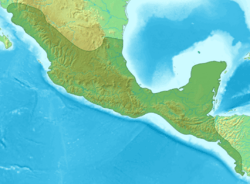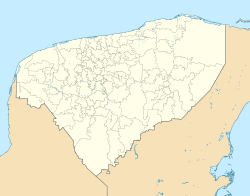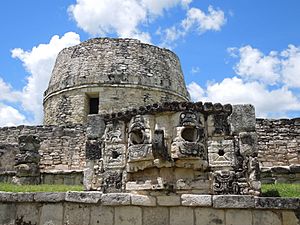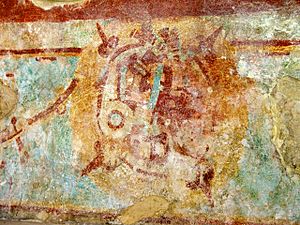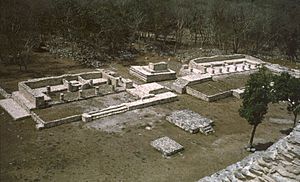Mayapan facts for kids
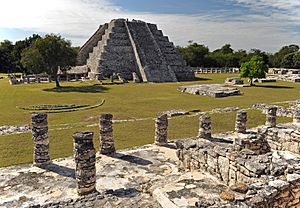
Temple of Kukulcan at Mayapan
|
|
| Location | Tecoh Municipality, Yucatán, Mexico |
|---|---|
| Region | Yucatán Peninsula |
| Coordinates | 20°37′46″N 89°27′38″W / 20.62944°N 89.46056°W |
| History | |
| Periods | Middle Preclassic to Late Postclassic |
| Cultures | Maya civilization |
Mayapan (also called Màayapáan in Modern Maya) was an important ancient Maya city. It is located in the Yucatán state of Mexico. You can find it about 40 kilometers (25 miles) southeast of Mérida.
Mayapan was the main city for the Maya people in the Yucatán Peninsula. It was their political and cultural center for over 200 years. This was during the Late Post-Classic period, from the 1220s to the 1440s. Experts believe that between 15,000 and 17,000 people lived there. The city had more than 4,000 buildings inside its walls. Archeologists have been studying and digging at Mayapan since 1939. They are still working there today to learn more about this amazing city.
Contents
Exploring Mayapan's Layout
Mayapan covers an area of 4.2 square kilometers (1.6 square miles). Most of its 4,000 buildings were homes. The city was surrounded by a strong stone wall. This wall was about 9.1 kilometers (5.7 miles) long. It had twelve gates, with seven main ones that had arched entrances.
The most important part of Mayapan was its ceremonial center. This area was packed with temples and other special buildings. These included halls with columns, small chapels, and altars. There were also platforms for speeches, dances, or displaying carved stone monuments called stelae.
Most of the people lived inside the city walls. Their homes were often grouped around small courtyards. The houses were built without organized streets. Instead, winding lanes connected the different residential areas. Mayapan also had many natural sinkholes, called cenotes. These were important sources of water for the city.
The Temple of Kukulcan
The biggest temple in Mayapan is the Temple of Kukulcan. It is also known as the Castillo. This large pyramid has four staircases and nine levels. It looks a lot like the famous Temple of Kukulcan at Chichen Itza. However, the buildings in Mayapan are not as well-built as those in older Maya cities. For example, many of Mayapan's vaulted roofs have fallen down. In contrast, many buildings at Chichen Itza are still standing strong.
Other important temples in Mayapan's center are round. Round temples are rare in the Maya world. They are also linked to the god Kukulcan, especially in his form as the wind god. Unlike Chichen Itza, Mayapan did not have any ballcourts.
Farming and Animals in Mayapan
The people of Mayapan likely grew their own food in mixed fields. These fields are called milpa fields. Today, farmers in the area still use milpa fields. They grow corn, beans, squash, and other crops. They also grow citrus fruits like oranges and limes near their homes.
Archeologists have found animal bones at Mayapan. These bones tell us what animals the people ate.
- In the main ceremonial center, they found:
* White-tailed deer (23%) * Turkey (12.9%) * Iguana (10.2%) * Dog (4.4%) * Fish (1.2%)
- In the residential areas, they found:
* Iguana (14.5%) * White-tailed deer (8.4%) * Turkey (5.3%) * Fish (3.6%) * Dog (1.4%)
They also found small amounts of turtle and rabbit bones. Interestingly, many fish skeletons were found, but very few fish heads. This suggests that fish were brought into Mayapan already prepared, not caught nearby.
Mayapan's Trade Network
Mayapan was a very important city in the Yucatán. There is a lot of evidence that it traded with many other places. This can be seen in the buildings and artifacts found there. A wide variety of goods were traded. These included everyday items like corn, honey, salt, and fish. They also traded luxury goods such as cotton cloth and birds. They would trade these for things they didn't have, like obsidian (a volcanic glass) and metal.
Images for kids
See also
 In Spanish: Mayapán para niños
In Spanish: Mayapán para niños


